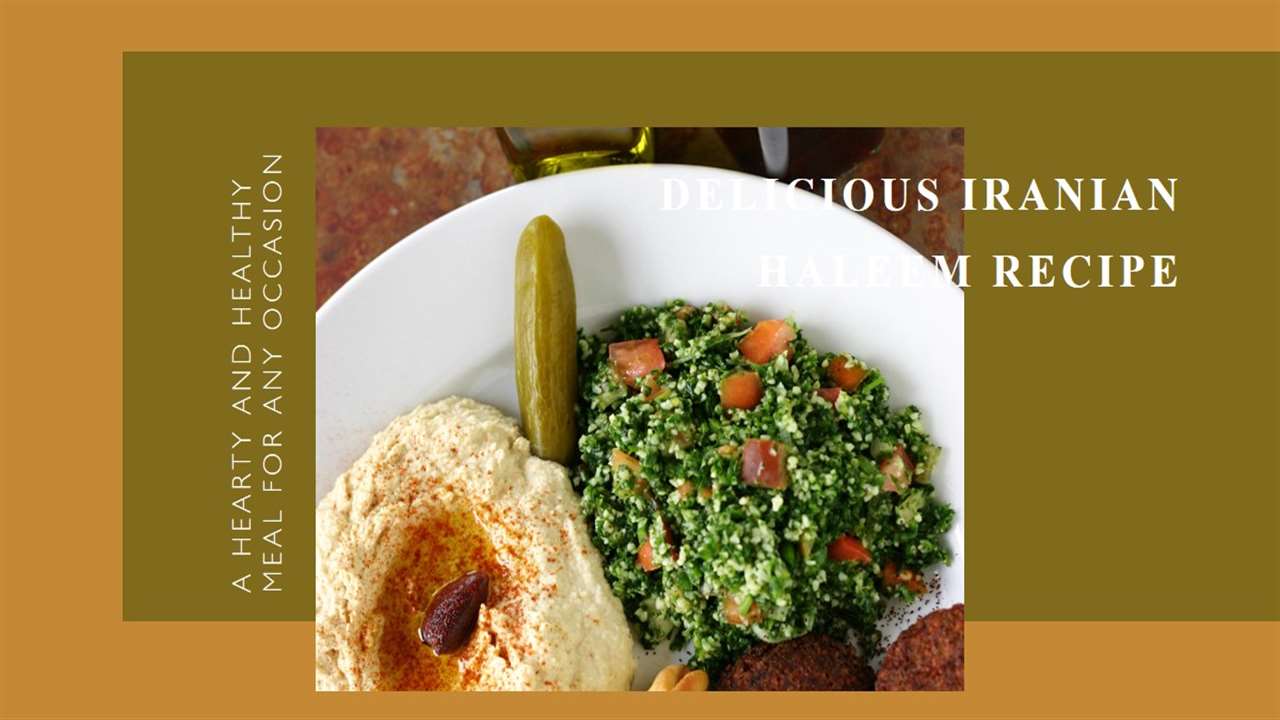Are you ready to explore the flavors of Iran through a dish that’s both comforting and nutritious? Iranian Haleem Recipe offers a unique blend of textures and tastes, combining meat, grains, and aromatic spices into a satisfying porridge-like consistency. In this article, we’ll walk you through the steps to create this traditional Iranian dish in your own kitchen. From selecting the right ingredients to mastering the cooking technique, get ready to embark on a culinary journey that celebrates Iranian cuisine!
Essential Ingredients for Iranian Haleem
Before you start cooking, gather all the essential ingredients required to make authentic Iranian Haleem.
Main Ingredients
- Lamb or Chicken: 500 grams of boneless lamb or chicken, cut into small pieces. Traditionally, lamb is used for its rich flavor.
- Wheat Berries: One cup of wheat berries, soaked overnight. These add a chewy texture to the dish.
- Split Yellow Peas: Half a cup of split yellow peas, soaked overnight. They provide a creamy consistency to the Haleem.
- Onions: Two large onions, finely chopped.
- Garlic: Four cloves of garlic, minced.
- Ginger: One-inch piece of ginger, grated.
- Turmeric: One teaspoon of ground turmeric.
- Cinnamon: One-inch stick of cinnamon.
- Cardamom: Two pods of cardamom, crushed.
- Salt and Pepper: To taste.
- Vegetable Oil: Three tablespoons of vegetable oil for cooking.
Garnishes
- Fried Onions: Thinly sliced onions fried until golden brown.
- Fresh Herbs: Chopped cilantro or parsley for garnishing.
- Lemon Wedges: For serving.
Step-by-Step Guide to Making Iranian Haleem
Let’s dive into the cooking process and create this delicious Iranian dish step-by-step.
Cooking the Meat and Grains
- Cooking the Meat: In a large pot, heat one tablespoon of vegetable oil over medium heat. Add the chopped onions and sauté until golden brown.
- Adding Meat: Add the lamb or chicken pieces to the pot and sauté until browned on all sides.
- Adding Spices and Aromatics: Stir in the minced garlic, grated ginger, ground turmeric, cinnamon stick, crushed cardamom pods, salt, and pepper. Cook for a few minutes until fragrant.
- Cooking Grains: Drain and rinse the soaked wheat berries and split yellow peas. Add them to the pot with the meat and spices. Stir well to combine.
Simmering the Haleem
- Adding Water: Pour enough water into the pot to cover the ingredients by about an inch.
- Simmering: Bring the mixture to a boil, then reduce the heat to low. Cover the pot and let it simmer gently for 2-3 hours, stirring occasionally. The grains and meat should become tender and the mixture should thicken into a porridge-like consistency.
Blending (Optional Step)
- Blending: For a smoother texture, you can blend the cooked Haleem using an immersion blender or in batches in a regular blender. This step is optional and depends on your preference for texture.
Serving Iranian Haleem
- Garnishing: Serve Iranian Haleem hot, garnished with fried onions, chopped fresh herbs, and lemon wedges on the side.
Serving Suggestions for Iranian Haleem
Iranian Haleem is a hearty dish that can be enjoyed on its own or with accompaniments. Here are a few serving suggestions:
Bread
Serve Iranian Haleem with warm flatbread or naan to soak up the flavorful broth.
Yogurt
A side of plain yogurt complements the richness of Haleem and provides a cooling contrast.
Pickles
Pickled vegetables or chutney can add a tangy bite to balance the savory flavors of the dish.
Tips and Tricks for Perfecting Iranian Haleem
To ensure your Iranian Haleem turns out perfectly every time, consider these additional tips:
Soaking Grains
Soaking wheat berries and split yellow peas overnight helps reduce cooking time and ensures they cook evenly.
Adjusting Consistency
If your Haleem is too thick after cooking, you can adjust the consistency by adding more hot water or broth until you reach your desired thickness.
Flavor Enhancement
For a richer flavor, you can add a tablespoon of ghee or butter towards the end of cooking.
Conclusion: Enjoy the Warmth of Iranian Haleem
Iranian Haleem is more than just a dish; it’s a comforting bowl of flavors that brings warmth to any table. With its tender meat, wholesome grains, and aromatic spices, this dish reflects the culinary heritage of Iran. Whether you’re craving a hearty meal or exploring new cuisines, Iranian Haleem promises to satisfy your taste buds and leave you craving more.
For more ideas, recipes, and cooking tips and tricks, please visit us at Herbb.
Frequently Asked Questions about Iranian Haleem Recipe
Can I use other meats instead of lamb or chicken?
Yes, you can substitute lamb or chicken with beef or even goat meat for a different flavor profile. Adjust cooking times accordingly based on the meat you choose.
How long can Iranian Haleem be stored?
Iranian Haleem can be stored in an airtight container in the refrigerator for up to 3-4 days. Reheat gently on the stovetop or microwave before serving.
Can I make Iranian Haleem vegetarian?
Yes, you can omit the meat and prepare a vegetarian version of Haleem using vegetables like carrots, potatoes, and peas. Increase the amount of spices and adjust seasoning to enhance flavors.
What can I serve with Iranian Haleem?
Iranian Haleem pairs well with bread, yogurt, pickles, and fresh salads. It can also be enjoyed with a side of steamed rice or couscous.
Is Iranian Haleem spicy?
The level of spiciness in Iranian Haleem can be adjusted according to your taste preferences. You can increase or decrease the amount of spices like red chili powder and black pepper accordingly.

